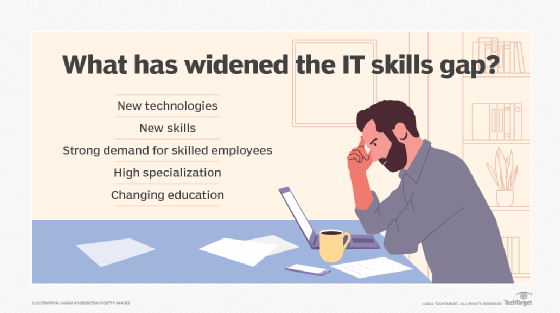
Fotolia
Close the tech skills gap with the right training
Employee skills are a valuable business resource. The scarcity of new or emerging IT skills has led to a skills gap that impedes tech adoption and business competitiveness.
Modern reliance on technology has placed a new business focus squarely on IT. Many future business initiatives involve IT budgets, operations and staffing. Successful business technology initiatives demand high-level employees with broad and proven skill sets to design, procure, deploy, maintain and manage modern IT projects.
But modern businesses face a serious staffing problem. It can be difficult to find and retain high-level employees who have the right mix of skills and expertise. Candidates don't apply, they lack the desired skills or simply want more money than tight IT budgets can accommodate. This phenomenon, called the IT skills gap or tech skills gap, can force a business to change, delay or even cancel vital projects as it seeks the right candidates.
Let's take a closer look at the IT skills gap, consider its potential effects on the business and see how training and mentorship programs address the problem.
Why is there an IT skills gap?
A skills gap is the difference between the skills that businesses require and those that employees possess. It's not a new issue -- and certainly not one limited to the IT industry -- and has always been present in business to some degree.
But the IT skills gap has proven more acute and problematic for the average IT business. Generally, five factors have precipitated today's tech skills gap.

New technologies. IT continues to evolve quickly, spawning new technologies that businesses use to cut costs, improve operational efficiency, enhance customer experiences and otherwise create a business advantage. For example, the rise of big data-enabled businesses to analyze extraordinary volumes of unrelated data to find new business opportunities and gain previously undiscoverable insights into operations. The ability to process and analyze oceans of data also enabled data-intensive technologies such as artificial intelligence and machine learning.
New skills. Each new technology demands experts with the skills and experience to use those technologies effectively, but new technologies also mean a small pool of expertise. Skills gaps are most acute for new and rapidly evolving technologies, such as:
- mobile application development;
- network virtualization;
- big data and related tasks, such as artificial intelligence and machine learning;
- IT security; and
- cloud technologies.
Strong demand. Once a technology demonstrates tangible benefits to a business, many businesses soon seek to deploy those same technologies and emulate the same successes. This creates a sudden demand for employees skilled in these technologies, which also keeps the candidate pool small.
High specialization. The sheer number of technologies available to modern business is bewildering. A single IT professional -- or type of IT professional, such as a systems admin -- is unlikely to possess all the possible skills and expertise that a business seeks. Like doctors or lawyers, IT professionals often specialize in certain technologies. For example, experts in AI might not be suitable candidates for mobile application development if they don't have experience in it -- even with their credentials.
Changing education. The role of education in technology is changing. Traditional formal degrees demonstrate solid educational foundations, but no longer indicate specific or advanced skill sets. Instead, IT professionals supplement formal degrees with a range of vendor-specific and third-party certifications, as well as various intensive boot camp programs. Consequently, it's harder for businesses to determine the relevance, quality or extent of candidates' education. This makes it more difficult to identify or compare qualified candidates objectively.
Repercussions of the IT skills gap
When a business can't find qualified candidates to do the desired IT projects and tasks for the available salary, what can it do?
Businesses always try to do more with less, and this philosophy often extends to employment. A typical IT job seeker doesn't need to look far to find high-level postings with dozens of detailed skill and experience requirements that are unrealistic or uncomfortably niche.
The business might look for candidates capable of handling varied, complex roles while limiting head count to be frugal. But potential IT candidates don't know which requirements are "must haves" and which are just "wishful thinking" on the hiring manager's part. Job seekers can easily pass on high-level opportunities because the requirements are too extensive and unrealistic -- or even impossible.
I saw a job post the other day.
— Sebastián Ramírez (@tiangolo) July 11, 2020
It required 4+ years of experience in FastAPI.
I couldn't apply as I only have 1.5+ years of experience since I created that thing.
Maybe it's time to re-evaluate that "years of experience = skill level". ♻
When candidates apply for a position, their skill sets don't match the position's requirements -- in objective terms, the skills don't align to the business goals. This causes the following three major problems for hiring managers:
- applicants appear unqualified or underqualified, which slows the hiring process;
- few candidates apply, so the business has few individuals to evaluate and select; and
- qualified candidates demand too much money.
Ultimately, the role goes unfilled, and lingering job requisitions can have consequences throughout the business. Open positions decrease the efficiency of IT teams. Existing projects might be delayed while new projects fail to launch. This delays project completion and affects time-to-market, which blunts competitive advantage and denies important revenue to the business. The IT team faces a greater collective burden, tasked to accomplish more with less staff. This often reduces job satisfaction and creates burnout, prompting skilled employees to leave -- further exacerbating the IT skills gap problem.
How to fix the IT skills gap
Organizations have used several strategies to address the IT skills gap, including temporary or contract employees and project outsourcing. While outside strategies address specific IT projects in the short term, these approaches generally do not help businesses identify and exploit the technologies needed for competitive growth.
Perhaps a greater vulnerability is the lack of a persistent knowledge base. When a contract or project is completed, the contractor leaves and usually takes the experience and knowledge of the client's infrastructure with them. In other words, the contractor benefits from the experience of the project, not the client business, which can create costly dependencies between a business and external contractors.
To solve the IT skills gap over the long term, a business should consider a strategic plan that involves employee training, development and retention.
- Training. Open new IT skills the employee does not have.
- Development. Direct, expand, improve and refresh skills that the employee already has.
- Retention. Create an environment of opportunity and compensation that attracts and retains IT talent.
However, such a plan demands a strong initiative and strategic thinking from business leaders. Rather than approach technology employment as an external effort to tackle projects or fill gaps, the business must reconsider technology as an internal initiative. This requires IT and business leaders to identify and promote specific skills and create the internal mechanisms to train and retain employees with those skills.
Creating an IT training program
Businesses that rely on technology for revenue and competitive advantage must explore the potential benefits of a meaningful, long-term IT mentoring or training program that facilitates in-house educational opportunities for IT staff. The training must meet the organization's strategic needs.
The common question for business leaders is how to go about the process. Training can take many forms, from freestyle self-directed tinkering -- experimenting in spare time -- to structured classroom-driven study, such as in-person continuing education classes.
Adult learners adept at learning complex technical concepts -- such as those in IT -- can usually study new topics with a high degree of success using a range of approaches. The learning process is a skill that requires practice -- just like the skill being learned -- and organizations benefit from continual training programs that keep staff flexible.
But that means what to train is also important. Take the following steps to establish a business-driven IT training initiative.
- Plan a roadmap. Business and IT leaders should start with a review of the business's roadmap and identify the business's major strategic objectives. Prioritize business goals first. For example, a roadmap review might identify the need for a wealth of unrelated data that the business is increasingly collecting to find new revenue opportunities.
- Determine key project(s). With a business goal in mind, leaders must identify one or more initiatives or projects necessary to realize the goals along that business roadmap. For example, big data projects might include the establishment of a computing cluster to ingest and analyze business data sources.
- Identify requisite skills. Next, leaders must identify the specific skills such projects require. There are likely to be several related or complementary skills. For example, the business might opt for cloud-based big data services to reduce the investment and risk to the local infrastructure. The business might identify a variety of skills that range from creating a cloud account and using cloud tools to setting up and using the providers' big data services.
- Evaluate available training forms. Once leaders know the necessary skills, they can identify the most effective and practical ways to train staff in those skills. Training opportunities take many forms, so it is worth investing time and effort to find available alternatives. Options include vendor certification programs, local and online college courses, external training experts in the desired skills or in-house employees who can share that knowledge.
- Get hands-on. Couple the training with practical opportunities to build expertise. Just as organizations support test and dev environments for software development teams, they should create a non-production test environment where learners can use -- and make mistakes with -- the tools and platforms related to their evolving skills. For the cloud big data example -- the test bed can be the cloud itself, where services and infrastructure can be enabled and paid for only as needed.
- Measure progress. Businesses should require a measurement of employee education to validate the organization's investment. External opportunities, such as formal certification programs and college courses, carry a final evaluation. Evaluations of in-house training efforts can be more challenging to implement, and might include informal testing and discussion with mentors.
- Incentivize growth. Businesses often include various incentives to promote successful learning. Examples might include reimbursement for training costs and allowing learners to participate in current projects for additional experience and mentorship.
- Repeat the cycle. This is an ongoing process. Revisit and repeat it on a regular basis to determine the program's efficacy. Identify and address any issues and regularly update the training program to fit the organization's ongoing needs.
This process is neither fast nor easy. It demands a consistent, long-term commitment and investment from business and IT leaders. It won't magically yield an ideal job candidate tomorrow or next week. But, if a business thinks strategically and cultivates the necessary IT skills, this process has the potential to increase its control over use of technology and lessen the overall tech skills gap across the industry.




